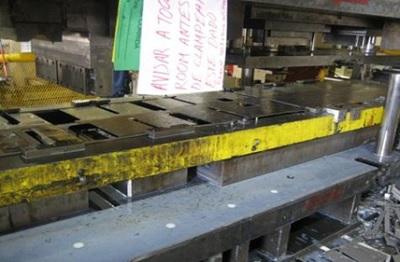Reduce Downtime in the Stamping Area with RFID
2022-12-21
What is an RFID process?
What are the benefits of RFID systems?

The home appliance industry is growing in record time. The increase in consumer demand for new household appliances is at an all-time high and is exceeding the current supply. Manufacturers of household appliances are increasing production to catch up with this demand. This makes the costs associated with downtime even higher than normal. But using industrial RFID can allow you to reduce downtime in your stamping departments and keep production moving.
Most major appliance manufacturers have large stamping departments as part of their manufacturing process. The tapping and vibration of the press at work is what feeds the rest of the plant. I was at a plant a few weeks ago meeting with an engineer in the final assembly area. It was strangely quiet in that area, so I asked what was going on. He said they had sent everyone home early because one of their main press lines was unexpectedly cut off. All departments were sent home because they did not have the necessary parts and parts to make the final product. That’s how critical the stamping departments are in these facilities.
In previous years, this was not so critical because they had an inventory of parts and finished products. But increased demand over the past two years depleted that inventory. They need ways to modernize the press shop, including implementing smarter products like devices with Industry 4.0 capabilities to get real-time data about the equipment for things like analytics, OEE (Overall Equipment Effectiveness), preventive maintenance, downtime, and more fail-safe applications.
Implementation of Industrial RFID
One of the first solutions that many appliance manufacturers implement in the press department is traceability using industrial RFID technology. Traceability is generally used to document and track different steps in a process chain to help reduce costs associated with non-compliance issues. This information is essential when a company needs to provide information for proactive product recalls, regulatory compliance and quality standards. In stamping departments, industrial RFID systems are often used for applications such as asset tracking, machine access control and die identification. Die ID is not only used to identify which die is present, but it can also be linked to the main press control system to make sure the correct job is loaded.
Traditionally, most companies have a die number painted on the die or have a sheet of paper with the job settings attached to the die. I can’t tell you how many times I’ve seen these papers on the floor. Press departments are quite unpleasant environments, so these papers spoil quite quickly. And the dice take a beating, so the painted numbers can be easily rubbed or scratched.
The implementation of RFID for die identification is a simple and affordable solution to this problem. First, you would attach an RFID tag with all the information about the job to each die. You can also write maintenance information about the die on this label, such as when the die was last worked on, who last worked on it, or process information such as how many parts have been made on this die.
Next, you need to attach an antenna. Most people mount the antenna on one of the columns of the press where the label would pass in front of it while loading on the die. The antenna would be linked to an IO-Link processor or master if IO-Link is used. The IO-Link processor or master would communicate with the main press control system. As the die is placed on the press, the antenna reads the label and tells the main control system which die is in place and which job to load.
In one stamping department you can find several large presses. Each press will have multiple dies associated with each press. Each die is configured to form a particular part. It is unique for the part it is forming and has its own recipe programmed into the main control system of the press. Many of the major stamping departments still use the operator’s manual input to set up and identify which tools are on the press. But the operators are human, so it is very easy to dial the wrong number, so RFID is a good automated solution.




